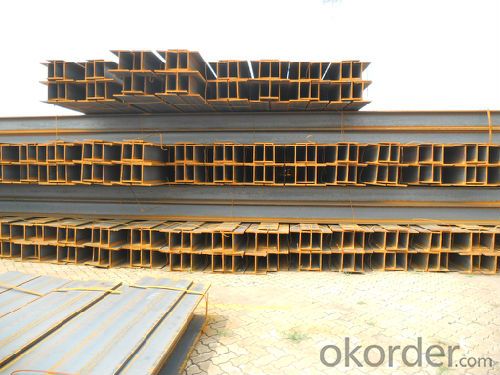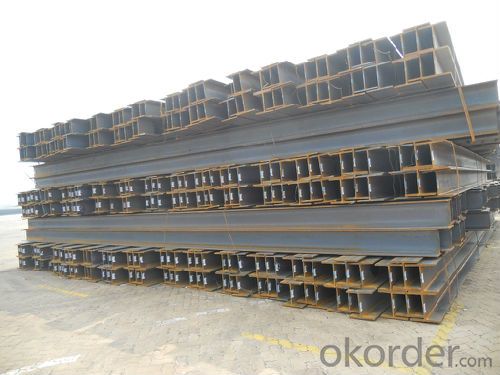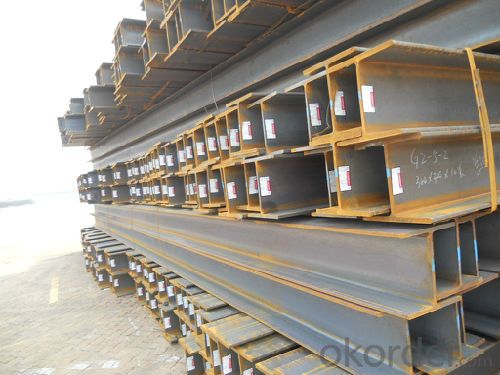H Iron Beam Structural Carbon Steel H Beam Profile (IPE,UPE,HEA,HEB)
- Loading Port:
- Tianjin
- Payment Terms:
- TT or LC
- Min Order Qty:
- 29 m.t.
- Supply Capability:
- 24000 m.t./month
OKorder Service Pledge
OKorder Financial Service
You Might Also Like
Product Description:
OKorder is offering H Iron Beam Structural Carbon Steel H Beam Profile (IPE,UPE,HEA,HEB) at great prices with worldwide shipping. Our supplier is a world-class manufacturer of steel, with our products utilized the world over. OKorder annually supplies products to European, North American and Asian markets. We provide quotations within 24 hours of receiving an inquiry and guarantee competitive prices.
Product Applications:
H Iron Beam Structural Carbon Steel H Beam Profile (IPE,UPE,HEA,HEB) are ideal for structural applications and are widely used in the construction of buildings and bridges, and the manufacturing, petrochemical, and transportation industries.
Product Advantages:
OKorder's H Iron Beam Structural Carbon Steel H Beam Profile (IPE,UPE,HEA,HEB) are durable, strong, and resist corrosion.
Main Product Features:
· Premium quality
· Prompt delivery & seaworthy packing (30 days after receiving deposit)
· Corrosion resistance
· Can be recycled and reused
· Mill test certification
· Professional Service
· Competitive pricing
Product Specifications:
1. Standard: GB, JIS, ASTM ST
2. Material: Q235, Q345, SS400, S235JR, S275JR, S355JR
3. Length: 5.8-12m or according to our clients' requirements
4. Origin: Tangshan, China
5. Package: load on 20 feet/40 feet container or by bulk according to the quantity and our client's requirement
6. Delivery time: within 20 days after receiving deposit or original L/C
7. Certificate: ISO, SGS, BV, CIQ or other test
8. Technic: Hot rolled
9: Surface: painted, galvanized or punch holes
10. Main market: East-south Asia, Mid-east, South American
11. Usage: Construction structure and Frame use
12. Other Main products: Angle steel, I beam and Channel steel
H Type Steel Size and Theoretical Weight | |||||
Size (mm) | Theoretical Weight (kg/m) | Size (mm) | Theoretical Weight (kg/m) | Size (mm) | Theoretical Weight (kg/m) |
100*50*5*7 | 9.3 | 250*125*6*9 | 29 | 446*199*8*12 | 65.1 |
100*100*6*8 | 16.9 | 250*250*9*14 | 71.8 | 450*200*9*14 | 74.9 |
125*60*6*8 | 13.1 | 294*200*8*12 | 55.8 | 482*300*11*15 | 110.8 |
125*125*6.5*9 | 23.6 | 298*149*5.5*8 | 32 | 488*300*11*18 | 124.9 |
148*100*6*9 | 31.1 | 340*250*9*14 | 36.7 | 496*199*9*14 | 77.9 |
150*75*5*7 | 14 | 300*150*6.5*9 | 93 | 500*200*10*16 | 88.1 |
150*150*7*10 | 20.7 | 300*300*10*15 | 78.1 | 582*300*12*17 | 132.8 |
175*90*5*8 | 18 | 346*174*6*9 | 41.2 | 588*300*12*20 | 147 |
175*175*7.5*11 | 40.4 | 350*175*7*11 | 49.4 | 596*199*10*15 | 92.4 |
194*150*6*9 | 29.9 | 350*350*12*19 | 134.9 | 600*200*11*17 | 103.4 |
198*99*4.5*7 | 17.8 | 390*300*10*16 | 104.6 | 700*300*13*24 | 181.8 |
200*100*5.5*8 | 20.9 | 396*199*7*11 | 56.1 | 800*300*14*26 | 206.8 |
200*200*8*12 | 49.9 | 400*200*8*13 | 65.4 | 900*300*16*28 | 240.1 |
244*175*7*11 | 43.6 | 400*400*13*21 | 171.7 | ||
248*124*5*8 | 25.1 | 440*300*11*18 | 120.8 | ||
Length=6-12meters | |||||
FAQ:
Q1: Why buy Materials & Equipment from OKorder.com?
A1: All products offered byOKorder.com are carefully selected from China's most reliable manufacturing enterprises. Through its ISO certifications, OKorder.com adheres to the highest standards and a commitment to supply chain safety and customer satisfaction.
Q2: How do we guarantee the quality of our products?
A2: We have established an advanced quality management system which conducts strict quality tests at every step, from raw materials to the final product. At the same time, we provide extensive follow-up service assurances as required.
Q3: How soon can we receive the product after purchase?
A3: Within three days of placing an order, we will begin production. The specific shipping date is dependent upon international and government factors, but is typically 7 to 10 workdays.



- Q:Can steel channels be used for equipment platforms?
- Indeed, equipment platforms can utilize steel channels. The robustness and endurance of steel channels make them prevalent in construction and industrial settings. They furnish a solid foundation for supporting weighty machinery on platforms, guaranteeing stability and security. Furthermore, steel channels can be effortlessly tailored and crafted to fulfill precise platform prerequisites, encompassing dimensions and load-bearing capabilities.
- Q:Can steel channels be used for retaining walls?
- Yes, steel channels can be used for retaining walls. Steel channels are strong and durable, making them suitable for supporting and retaining soil or other materials in various construction projects, including retaining walls.
- Q:What are the different types of loads that steel channels can bear?
- Steel channels exhibit versatility as structural components capable of bearing different types of loads. The array of loads they can endure includes: 1. Compression Load: With a high load-bearing capacity, steel channels can effectively withstand compression forces. They find common usage in columns and beams, providing support for the weight of structures and facilitating vertical load transfer. 2. Tension Load: Steel channels possess the capability to resist tension loads, effectively countering forces that aim to pull or stretch the material. This attribute renders them appropriate for applications such as trusses or suspension systems. 3. Shear Load: Steel channels exhibit resilience against shear forces, which arise when two parallel forces exert themselves in opposite directions. They frequently find application in structural systems, effectively counteracting the shearing effects of horizontal loads like wind or seismic forces. 4. Bending Load: Steel channels proficiently bear bending loads, which emerge when forces are applied perpendicularly to the channel's axis. They are often utilized as beams or lintels, providing support for loads positioned over openings like doors or windows. 5. Axial Load: Steel channels are designed specifically to withstand axial loads, which act along the channel's longitudinal axis. These loads can either be compressive or tensile and are typically encountered in columns or vertical members. 6. Lateral Load: Steel channels possess the ability to bear lateral loads, which exert themselves perpendicular to the channel's longitudinal axis. These loads commonly originate from wind, earthquakes, or other horizontal forces and are effectively countered by the structural system incorporating the channel. In conclusion, steel channels offer a versatile option for structural applications due to their capacity to bear various types of loads. Their strength, durability, and flexibility render them suitable for an extensive range of construction and engineering projects.
- Q:Can steel channels be welded?
- Yes, steel channels can be welded.
- Q:What are the different insulation options for steel channels?
- There are several insulation options available for steel channels, depending on the specific requirements and environmental conditions. Some of the commonly used insulation options include: 1. Mineral wool insulation: Mineral wool is a popular choice for insulating steel channels due to its excellent thermal and acoustic insulation properties. It is made from natural or synthetic minerals and is available in various forms like batts, blankets, or loose-fill. Mineral wool insulation is non-combustible, does not absorb moisture, and provides effective insulation against heat transfer and sound transmission. 2. Foam insulation: Foam insulation is another widely used option for insulating steel channels. There are different types of foam insulation, including rigid foam boards and spray foam. Rigid foam boards are typically made of polystyrene or polyurethane and can be easily cut and fitted into steel channels. Spray foam, on the other hand, is applied as a liquid that expands and hardens into a solid foam, providing excellent insulation and air sealing. 3. Fiberglass insulation: Fiberglass insulation is a common choice for insulating steel channels as it is affordable and easy to install. It is made from glass fibers and is available as batts or loose-fill. Fiberglass insulation is effective in reducing heat transfer and can also provide acoustic insulation. However, it is important to ensure proper installation to avoid any gaps or compression that could reduce its effectiveness. 4. Reflective insulation: Reflective insulation is commonly used in steel channels for its ability to reflect radiant heat. It consists of a reflective surface, often made of aluminum foil, that is installed facing an air gap. This air gap helps in reducing heat transfer through radiation. Reflective insulation is lightweight and easy to install, making it a suitable option for steel channels. 5. Cellular glass insulation: Cellular glass insulation is a specialized option that is highly resistant to moisture and provides excellent thermal insulation. It is made from glass and has a closed-cell structure, which makes it impermeable to water and resistant to mold growth. Cellular glass insulation is often used in applications where high temperature resistance or resistance to moisture is required. It is important to consider factors such as thermal conductivity, fire resistance, moisture resistance, and acoustic performance when selecting insulation for steel channels. Consulting with a professional or insulation manufacturer can help determine the most suitable option based on specific requirements and budget constraints.
- Q:How do steel channels contribute to the overall design flexibility of a project?
- Steel channels play a crucial role in enhancing the design flexibility of a project in multiple ways. Firstly, they come in a wide array of sizes and dimensions, enabling architects and engineers to select the most appropriate channel that caters to the specific structural demands of their project. This assortment of sizes facilitates the creation of intricate and complex designs that can accommodate various load-bearing needs. Moreover, steel channels can be easily customized through cutting, welding, and modification, making them highly adaptable. This flexibility allows for the development of distinctive and innovative designs that align with the specific requirements and vision of the project. Whether it involves constructing beams, columns, or frameworks, steel channels can be manipulated to fit the desired shape and size, offering endless possibilities for architectural creativity. Furthermore, steel channels possess an exceptional strength-to-weight ratio, ensuring the structural integrity of the project while optimizing material usage. This characteristic allows for a more resource-efficient approach and cost-effective construction. Additionally, steel channels exhibit exceptional durability, corrosion resistance, and fire resistance properties, making them suitable for a wide range of applications in various industries. In conclusion, the utilization of steel channels in a project enhances design flexibility by providing a diverse range of sizes, customization options, and an excellent strength-to-weight ratio. These attributes empower architects and engineers to create distinct and efficient designs that meet specific requirements while guaranteeing durability and cost-effectiveness.
- Q:Can steel channels be used for cable management?
- Yes, steel channels can be used for cable management. Steel channels are often used in industrial and commercial settings to organize and protect cables. They provide a durable and secure solution for managing cables by keeping them organized, preventing them from being damaged or tangled, and allowing for easy access and maintenance. Steel channels can be mounted on walls or ceilings and can accommodate various types and sizes of cables. They are particularly useful in environments where there is a need for heavy-duty cable management, such as data centers, manufacturing facilities, and construction sites.
- Q:How do steel channels contribute to acoustic performance?
- Steel channels can play a significant role in improving acoustic performance in various applications. One of the key contributions of steel channels to acoustic performance is their ability to minimize sound transmission and improve sound insulation. Steel channels are often used as part of wall or ceiling systems in buildings to create a barrier that prevents sound from traveling between different spaces. The design and construction of steel channels allow for the installation of sound insulation materials such as mineral wool or acoustic foam. These materials help to absorb and dampen sound waves, reducing the transmission of noise from one area to another. By incorporating steel channels in the construction of walls or ceilings, the overall acoustic performance of a space can be greatly enhanced. In addition to their sound insulation properties, steel channels can also contribute to the improvement of room acoustics. By using steel channels to create a suspended ceiling, for example, it is possible to create a more balanced and controlled sound environment. The space between the steel channels can be filled with acoustic tiles or panels, which can absorb sound reflections and reduce echoes, resulting in better speech intelligibility and overall sound quality. Moreover, steel channels can also be used to support the installation of sound-absorbing materials on walls or ceilings. These materials, such as fabric-wrapped panels or perforated metal sheets, can help to reduce reverberation and echo in a room, improving its acoustic performance. Steel channels provide a sturdy framework to securely mount these materials, ensuring their effectiveness in enhancing sound absorption. Overall, steel channels contribute to acoustic performance by reducing sound transmission, improving sound insulation, and enhancing room acoustics. Whether used in the construction of walls, ceilings, or as a support for sound-absorbing materials, steel channels play a vital role in creating a more acoustically favorable environment, whether it be in residential, commercial, or industrial settings.
- Q:What are the different load combinations considered for steel channels?
- The different load combinations considered for steel channels typically include dead loads, live loads, wind loads, and seismic loads. Dead loads refer to the weight of the structure itself and any permanent fixtures or equipment. Live loads account for the varying weights and forces imposed by occupants, furniture, and other temporary loads. Wind loads take into account the pressure and suction forces exerted by wind on the structure. Seismic loads consider the potential ground shaking during an earthquake. These load combinations are analyzed and designed to ensure the steel channels can safely withstand the forces and maintain structural integrity.
- Q:Can steel channels be used in the aerospace parts manufacturing industry?
- Indeed, the aerospace parts manufacturing industry can employ steel channels. The construction of aircraft structures and components often relies on steel channels, owing to their remarkable attributes of strength, durability, and resistance to deformation. Framing, support structures, and reinforcement for crucial aerospace parts are among the diverse applications that steel channels can fulfill. By providing structural integrity and stability, steel channels play a pivotal role in ensuring the secure and dependable operation of aerospace vehicles. Moreover, the aerospace industry benefits from the ease of fabrication and welding that steel channels offer, rendering them an excellent choice that upholds precision and quality, which are paramount in this field.
1. Manufacturer Overview |
|
|---|---|
| Location | |
| Year Established | |
| Annual Output Value | |
| Main Markets | |
| Company Certifications | |
2. Manufacturer Certificates |
|
|---|---|
| a) Certification Name | |
| Range | |
| Reference | |
| Validity Period | |
3. Manufacturer Capability |
|
|---|---|
| a)Trade Capacity | |
| Nearest Port | |
| Export Percentage | |
| No.of Employees in Trade Department | |
| Language Spoken: | |
| b)Factory Information | |
| Factory Size: | |
| No. of Production Lines | |
| Contract Manufacturing | |
| Product Price Range | |
Send your message to us
H Iron Beam Structural Carbon Steel H Beam Profile (IPE,UPE,HEA,HEB)
- Loading Port:
- Tianjin
- Payment Terms:
- TT or LC
- Min Order Qty:
- 29 m.t.
- Supply Capability:
- 24000 m.t./month
OKorder Service Pledge
OKorder Financial Service
Similar products
New products
Hot products
Related keywords


























